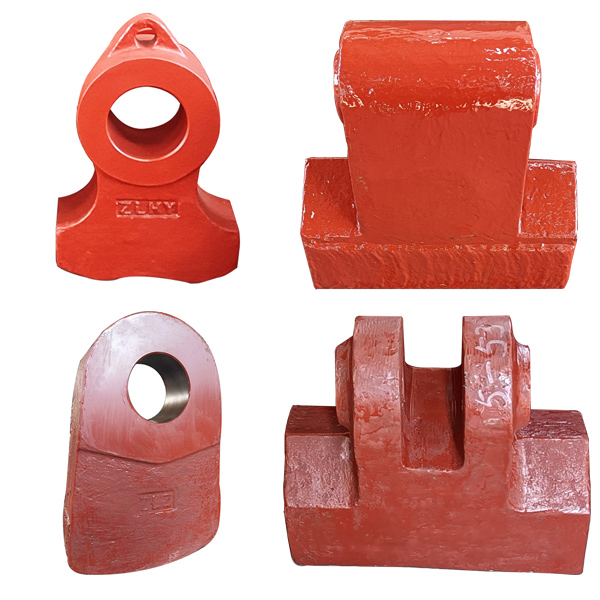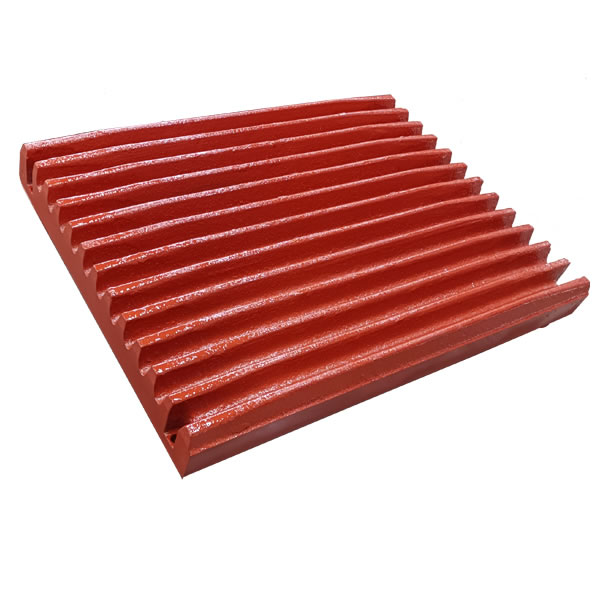Detailed Explanation of Wear-Resistant Parts for Apron Feeders
- 2025-08-12
- view countïž
Apron feeders are critical equipment for handling large, sharp, hot, or highly abrasive materials (such as ore, limestone, scrap steel, slag, etc.). Their wear resistance is directly related to equipment life and operating costs. Key wear-resistant parts include:
Conveyor chain plates:
Core wear parts: These directly carry the material and withstand the greatest impact, friction, and wear.
Material: Typically constructed from high-strength, wear-resistant alloy steels, such as:
High-manganese steel: Hardens under strong impact conditions, forming a high-hardness, wear-resistant layer.
Medium-carbon alloy steel: High hardness and toughness are achieved through heat treatment (quenching and tempering).
Wear-resistant steel plates: Products such as Hardox, JFE-Everhard, and NM series offer excellent wear resistance and weldability.
Surface hardening treatments: Examples include cladding and spraying wear-resistant coatings.
Structure: The chain plate may be designed with ribs, raised points, or special shapes to increase rigidity and reduce sliding friction.
Key Transmission Components: Responsible for transmitting tension and driving the chain plates. Chain pins, chain plate holes, and the inner bores of bushings (or rollers) are the primary wear areas.
Material and Treatment:
Chain plates, pins, and bushings are typically made of high-quality alloy steel (such as 40CrNiMoA, 42CrMo).
Key friction surfaces (pin outer surface, bushing/roller inner bore) undergo surface hardening treatments such as carburizing, carbonitriding, medium-frequency quenching, and surface welding of a wear-resistant layer to increase hardness and wear resistance.
Some designs use chains with wear-resistant bushings.
Sprocket:
Meshing Wear Components: The chain meshes with sprocket teeth to transmit power, subjecting the tooth surfaces to significant pressure and sliding friction.
Materials and Treatment:
The wheel body is typically made of cast steel (such as ZG310-570, ZG42CrMo) or forged steel.
The tooth surface must be deep-hardened. Common methods include:
Through quenching and tempering (to ensure core toughness).
High-frequency/medium-frequency quenching of the tooth surface.
Welding a wear-resistant alloy layer (such as high-chromium cast iron or tungsten carbide composite) onto the tooth surface.
Install a replaceable wear-resistant gear ring or gear segment.
The tail pulley is typically treated similarly. If the design is a smooth pulley (without teeth), the wheel flange also requires wear-resistant treatment.
Railway (running rail, return rail/support rail):
Support and Guide: The chain (usually via rollers or shoes) runs on the rail, supporting the chain plates and the weight of the material. The rail is subject to rolling or sliding friction wear.
Material:
High-strength, wear-resistant rails or steel sections (such as QU80 and QU100 crane rails) are typically used.
The track running surface can be welded with a wear-resistant layer or equipped with replaceable wear strips/plates (materials can be high-manganese steel, wear-resistant alloy steel, or even engineering plastics such as UHMW-PE for low-load or return sections).
Designed to be adjustable or reversible for extended service life.
Trainer (Return Trainer/Support Roller):
Return Chain Support: Supports the unloaded return chain to reduce sagging and wear.
Material: The wheel body is cast steel or welded. The wheel flange running surface requires hardening (quenching, welded with a wear-resistant layer) or installation of a wear-resistant sleeve.
Tensioner Slide/Slide Plate:
Guide Tensioner Movement: The tensioner slides on the slide rail to adjust chain tension, resulting in sliding friction on the contact surface.
Material: The slide rail and slide plate are typically made of wear-resistant steel plate or welded with a wear-resistant layer.
Side Liners/Guide Plates:
Preventing Material from Spilling and Abrasion: Installed on both sides of the silo outlet, these guide materials onto the chain and protect the sidewalls.
Material: Commonly used are wear-resistant steel plate, high-manganese steel castings, wear-resistant rubber, or ceramic composite liners. They must withstand the impact and sliding friction of the material.
Tail Hopper Liner (if applicable):
Protecting the hopper: When materials are discharged from the tail of the chain into downstream equipment (such as a crusher), the hopper's inner wall is subject to material impact and friction.
Material: Similar to side liners, these are made of wear-resistant steel plate, high-manganese steel, rubber, or ceramic liners.
Key Considerations for Wear-Resistant Accessories:
Material Characteristics: Hardness, particle size, shape (sharpness), humidity, temperature, and corrosiveness.
Operating Conditions: Load size, operating speed, and impact strength.
Cost-Effectiveness: Initial cost, ease of replacement, service life, and downtime losses.
Maintainability: Is the part easy to replace and is it designed for reversible or symmetrical use?
Summary: The core wear resistance of an apron feeder lies in four components: the conveyor chain, chain, sprocket tooth surface, and running track. Choosing the appropriate material and hardening process, combined with a sound structural design (such as replaceable wear blocks and reversible operation), is key to extending the equipment's wear life and reducing maintenance costs. The wear resistance of other components, such as rollers, tensioning rails, and liners, also needs to be considered based on specific operating conditions. When purchasing spare parts, be sure to provide the equipment model and detailed operating conditions to ensure a compatible fit and optimal wear resistance.
We hope this information will help you better maintain your equipment. If you have questions about selecting a suitable part for your specific application, please feel free to discuss further.


